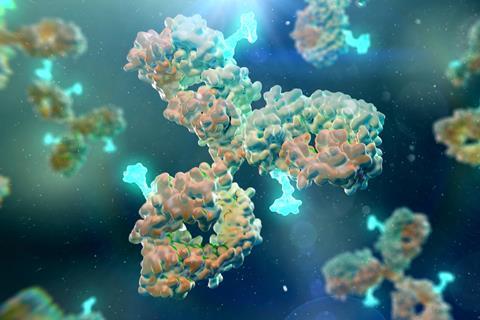
Enhertu (trastuzumab deruxtecan), has become the first antibody—drug conjugate (ADC) to receive US approval for treating cancer based on the molecular profile of the tumour rather than its location of origin. The approval is based on positive results from clinical trials of the drug against a range of cancers expressing human epidermal growth factor receptor 2 (HER2).
‘This is a globally important finding because there are many cancers where there is HER2 expression,’ says Funda Meric-Bernstam, an oncologist at the University of Texas, US, who coordinated one of the trials that supported pan-tumour approval by the US Food and Drug Administration (FDA).
The drug combines an antibody (trastuzumab – marketed as a cancer therapy on its own as Herceptin) for homing in on the target, with a cell-killing payload of deruxtecan, a topoisomerase 1 inhibitor that interfere with DNA replication during cell division. It was jointly developed by Daiichi Sankyo and AstraZeneca.
Enhertu had already been approved for breast cancer, metastatic lung cancer and stomach cancer. Its recent pan-tumour approval was based on three specially-designed clinical trials where it shrank a variety of tumours in many people with advanced HER2-positive cancers.
There are a small number of other antibody and small-molecule therapies that have some degree of location-agnostic approval based on molecular or gene profiling. More pan-tumour ADC approvals could follow on from Enhertu. ‘This has great implications for the field because many other antibody-drug conjugates were being developed based on disease types, but maybe we can look more broadly,’ says Meric-Bernstam.
Broad approval
One standout finding with Enhertu was that it was active not only in tumours with high HER2 expression, but also in breast cancer with lower HER2 expression. ‘HER2 is an especially compelling target because it is expressed across many tumour types,’ says Meric-Bernstam.
The Destiny-PanTumor02 trial was designed to indicate whether the drug could work in cancers that would be too rare to run individual clinical trials for, but that can be tested for HER2. There were positive results in gynaecological cancers, even with lower expression of HER2. And while the results pancreatic and biliary cancer were less dramatic, there were still clear benefits, says Meric-Bernstam. ‘Over half the patients had responses, meaning 30% or greater decrease in their tumour burden, and these responses last for a long time,’ she adds.
‘We can have confidence that if a patient has a disease with HER2 expression, there is a likelihood that trastuzumab deruxtecan will have anti-tumour efficacy,’ says Meric-Bernstam, adding that the results make it worthwhile routinely testing patients with advanced metastatic cancer for HER2 expression.
Of the 15 ADCs so far approved to treat cancer, ten gained approval since 2019. Another dozen or so are in late-stage clinical trials. ‘There’s been a lot of excitement over the past five years with these ADCs that have shown very impressive activity as compared with chemotherapy,’ says Aditya Bardia, an oncologist at the University of California, Los Angeles in the US.
Since the first ADCs were developed, there have been major advances in antibody design, target selection, linkers and cell-killing payloads. ‘A problem with the first generation of antibody-drug conjugates was that the linker was not stable and resulted in significant off-tumour toxicity,’ Bardia explains.
Linkers are crucial for safety and potency. Once the antibody has bound to its target on the cell surface, the whole drug must get inside a cell to release the cytotoxic compounds. If the linker is unstable, the payload can fall off and affect healthy cells. ‘Newer ADCs have a more stable linker, which has reduced toxicities,’ says Bardia.
Loading up
There have been arguably surprising trends in the types of drugs placed on ADCs. Newer, highly potent agents that bind DNA (such as pyrrolobenzodiazepine) proved mostly too toxic in trials, with only Zynlonta (loncastuximab tesirine) for B-cell lymphoma approved. This had a drug-antibody ratio (DAR) of just two – meaning on average there are two payload molecules attached to each antibody.
If a warhead is extremely potent, then a lower DAR is suitable. To reach an effective dose of a less-toxic payload, a higher DAR is required. But that can mean more payload molecules may fall off, which can kill healthy cells and cause side effects. ‘Conventional thinking five to 10 years ago favoured highly toxic payloads, but Enhertu goes the other way,’ says Andy Hsieh, market analyst with William Blair.
Higher DARs required advances in linker technology. For example, making linkers more hydrophobic helped overcome problems of hydrophobicity of the payload molecules. This allows the DARs of between seven and eight achieved with less potent topoisomerase 1 inhibitor payloads in in Enhertu and Gilead’s Trodelvy (sacituzumab govitecan).
‘The DAR of eight allows you to target what were inaccessible tumour cells,’ says Hsieh. This is because more cancer-killing molecules are around to spill out of target cancer cells and kill nearby bystander cells. This is useful because tumours are often complex and heterogeneous, with not all cells expressing the same genetic profile.
Trodelvy and Enhertu are believed to also kill cells that lack the target receptor for their antibodies by diffusion of the payload. For example, when Enhertu gets inside a cancer cell, deruxtecan is released and kills the cell. However, because deruxtecan is membrane permeable, it can then enter nearby cells that do not express HER2 and terminate them. However, there is also the possibility of damaging healthy cells around the site of the tumour.
Overall, this has delivered benefits to patients. Trodelvy – which targets tumour-associated calcium signal transducer 2 – was approved for metastatic breast cancer and bladder cancer in the US in 2020 and in the EU in 2021. ‘It showed doubling of overall survival, something we had not seen in triple-negative breast cancer [tumours that don’t express receptors for either oestrogen, progesterone or HER2],’ says Bardia, who led the clinical trials of Trodelvy.
He says ADCs have ‘changed the therapeutic landscape for breast cancer.’ His group’s focus now is to move the drug to early breast cancer to prevent the return of triple-negative breast cancer.
Commercial clamour
For now, commercial interests in ADCs are focused on cancer. ‘Most pharma companies want exposure to ADCs as part of their strategy, but some companies really have ADCs as an anchoring strategy,’ says Hsieh. Earlier this year, it was reported that Daiichi Sankyo raised its sales forecast for the 12 months ending in March to $2.6 billion (£2 billion) for Enhertu. This success is drawing renewed attention on the commercial potential of ADCs for cancer.
AstraZeneca’s partnership with Daiichi Sankyo for its linker-payload technology, which produced Enhertu, positions them as leaders in the field. Meanwhile, Pfizer agreed to pay $43 billion in 2023 for Seattle-based ADC pioneer Seagen. And earlier this year Johnson & Johnson completed its $2 billion acquisition of Ambrx.
In February, AbbVie completed a $10 billion takeover of ImmunoGen, giving it the only ADC approved for ovarian cancer, Elahere (mirvetuximab soravtansine). Genmab agreed to buy ProfoundBio for $1.8 billion to boost its ADCs for solid tumours in April.
‘There’s a lot of excitement related to ADCs. Every few months, we read about big pharma buying a smaller company for its ADC portfolio,’ says Bardia.
Also active in this space are GSK, Roche, Takeda Pharmaceuticals and Bristol Myers Squibb, which signed a $1 billion licensing agreement with Tubulis to develop ADCs. ‘For big pharma, decisions are always revenue driven and ADCs are becoming de-risked,’ says Hsieh.
Linker letdown
Despite progress, there are still many opportunities to improve linker chemistry. ‘The majority of ADCs are attached to an antibody via a maleimide cysteine linkage,’ says David Spring, an organic chemist at the University of Cambridge, UK.
‘It’s very good for chemical biology and short-term studies,’ he says, ‘but these are unstable linkages, and the drug can be falling off within a matter of days, leading to systemic toxicity.’ This is because it is unstable in blood plasma, at pH 7.3, leading to a retro-Michael addition, a reverse of the reaction that formed the linkage.
His group has reported on arylsulfate-containing ADC linkers that are stable in plasma, but can be cleaved by sulfatase enzymes in the lysosome once inside the cell. The team has also developed a strategy for loading odd-integer DARs (which are harder to produce than even numbers) using disulfide re-bridging. Spring says not enough chemists have been involved in improving linker technology.
This all leaves plenty of room to improve an already commercially successful strategy for treating cancer. And there are moves to attach not just cell-killing molecules to the antibodies of ADCs. For example, Genentech has developed an experimental ADC to eliminate reservoirs of Staphylococcus aureus bacteria inside cells. More recently, Spring and colleagues in Cambridge have been looking into antibodies that target tuberculosis. ‘Other strategies are being considered such as adding immune modulators or novel payload to antibodies,’ says Meric-Bernstam.


















No comments yet